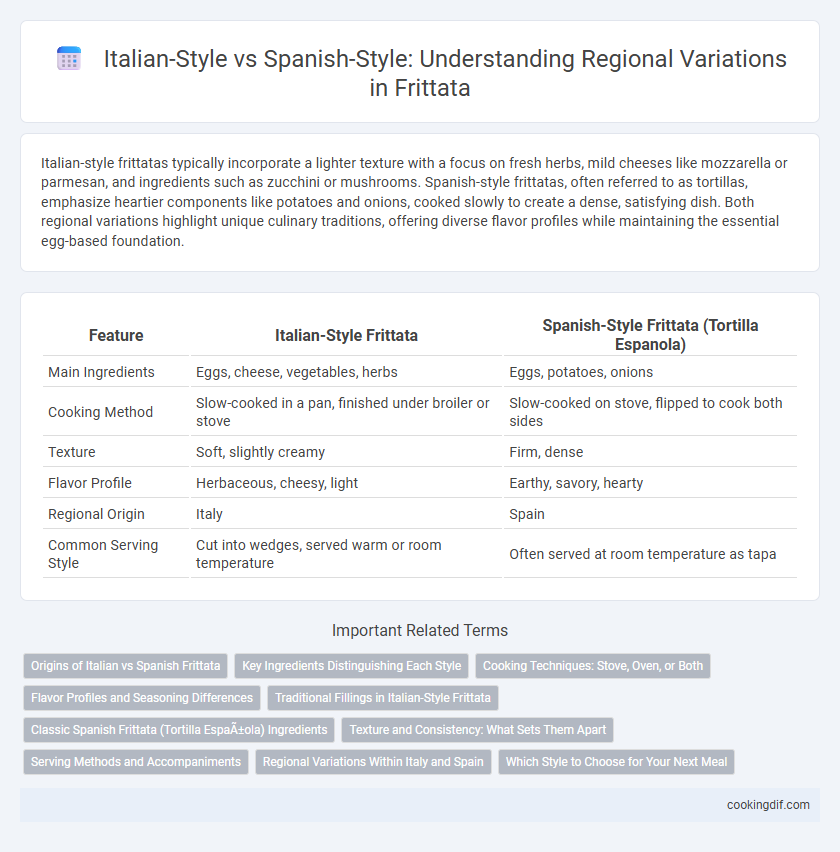Italian-style frittatas typically incorporate a lighter texture with a focus on fresh herbs, mild cheeses like mozzarella or parmesan, and ingredients such as zucchini or mushrooms. Spanish-style frittatas, often referred to as tortillas, emphasize heartier components like potatoes and onions, cooked slowly to create a dense, satisfying dish. Both regional variations highlight unique culinary traditions, offering diverse flavor profiles while maintaining the essential egg-based foundation.
Table of Comparison
| Feature | Italian-Style Frittata | Spanish-Style Frittata (Tortilla Espanola) |
|---|---|---|
| Main Ingredients | Eggs, cheese, vegetables, herbs | Eggs, potatoes, onions |
| Cooking Method | Slow-cooked in a pan, finished under broiler or stove | Slow-cooked on stove, flipped to cook both sides |
| Texture | Soft, slightly creamy | Firm, dense |
| Flavor Profile | Herbaceous, cheesy, light | Earthy, savory, hearty |
| Regional Origin | Italy | Spain |
| Common Serving Style | Cut into wedges, served warm or room temperature | Often served at room temperature as tapa |
Origins of Italian vs Spanish Frittata
Italian frittata originated from Italy's Emilia-Romagna region, characterized by its thick, open-faced omelet often enriched with local cheeses, vegetables, and herbs. Spanish frittata, known as tortilla espanola, derives from Castilla-La Mancha and features a denser texture primarily made with eggs, potatoes, and onions cooked slowly to create a firm yet tender dish. Both versions reflect regional ingredients and cooking techniques rooted in their respective Mediterranean culinary traditions.
Key Ingredients Distinguishing Each Style
Italian-style frittata typically incorporates eggs, Parmesan cheese, fresh herbs such as basil or parsley, and a variety of vegetables like zucchini or tomatoes, offering a lighter, more delicate texture. Spanish-style frittata, known as tortilla espanola, features key ingredients like potatoes and onions, cooked slowly to create a dense, hearty dish with a golden crust. The use of olive oil in both styles is fundamental, but the emphasis on potatoes in the Spanish variation marks the primary regional distinction.
Cooking Techniques: Stove, Oven, or Both
Italian-style frittatas typically start on the stove and finish in the oven, creating a fluffy texture with a lightly browned top. Spanish-style frittatas, known as tortillas, are primarily cooked entirely on the stove, often flipped to ensure even cooking and a firm, dense consistency. Combining both techniques influences the frittata's texture and flavor, reflecting regional culinary traditions within Italy and Spain.
Flavor Profiles and Seasoning Differences
Italian-style frittatas feature delicate flavors with fresh herbs like basil, parsley, and oregano, often accented by Parmesan cheese and subtle garlic. Spanish-style frittatas, also known as tortilla espanola, emphasize bold seasoning with paprika, onions, and sometimes chorizo, creating a heartier, smoky flavor. The seasoning differences highlight the Italian preference for herbaceous, light profiles versus the robust, spiced notes typical of Spanish cuisine.
Traditional Fillings in Italian-Style Frittata
Italian-style frittata traditionally incorporates a variety of fillings such as cheeses like Parmigiano-Reggiano, fresh herbs like basil and parsley, and vegetables including zucchini, mushrooms, and tomatoes. These ingredients reflect the regional Italian emphasis on fresh, local produce and subtle seasoning to enhance natural flavors. In contrast to the Spanish-style tortilla, which often centers around potatoes and onions, Italian frittatas favor lighter, more diverse fillings that contribute to a delicate texture and rich taste.
Classic Spanish Frittata (Tortilla Española) Ingredients
Classic Spanish frittata, known as Tortilla Espanola, primarily consists of eggs, thinly sliced potatoes, onions, olive oil, and salt, creating a hearty and flavorful dish. Unlike the Italian frittata, which often incorporates a variety of vegetables, cheeses, and meats, the Spanish version emphasizes simplicity and the slow-cooking of potatoes and onions to achieve a tender texture. This regional variation highlights traditional Mediterranean ingredients, reflecting Spain's culinary focus on rustic, satisfying flavors.
Texture and Consistency: What Sets Them Apart
Italian-style frittatas feature a creamy, custard-like texture achieved by slow cooking eggs with cheese, vegetables, and meats until gently set but still moist. Spanish-style frittatas, or tortillas, boast a denser, firm consistency, often enriched with potatoes and onions, cooked evenly through a stovetop and finished in the oven or flipped, creating a cohesive, sliceable dish. The primary distinction lies in Italian frittatas' light, airy texture versus the Spanish tortilla's hearty, compact structure.
Serving Methods and Accompaniments
Italian-style frittata is commonly served sliced and warm or at room temperature, often accompanied by fresh salads, crusty bread, and a drizzle of olive oil, highlighting its rustic Mediterranean roots. In contrast, Spanish-style frittata, or tortilla espanola, is traditionally cut into wedges and served as tapas, accompanied by olives, aioli, and sometimes cured meats, reflecting its role in casual, social dining. These regional serving methods emphasize the cultural and culinary distinctions between the softer, more homogenous Italian frittata and the thicker, potato-rich Spanish tortilla.
Regional Variations Within Italy and Spain
Italian-style frittatas vary by region, with Northern Italy favoring rich ingredients like cheese and cured meats, while Southern Italy incorporates vegetables such as zucchini and tomatoes for a lighter texture. In Spain, variations of the Spanish-style frittata, or tortilla espanola, emphasize the use of potatoes and onions, especially in regions such as Andalusia and Castilla-La Mancha, where the tortilla is often denser and thicker. Both styles reflect local produce and culinary traditions, highlighting the adaptability of frittatas across Mediterranean cuisine.
Which Style to Choose for Your Next Meal
Italian-style frittatas feature a thick, fluffy texture achieved by slowly cooking eggs with ingredients like cheese, vegetables, and meats, offering a rich and hearty flavor. Spanish-style frittatas, often known as tortilla espanola, emphasize potatoes and onions cooked within the eggs, creating a denser and more savory dish ideal for filling meals. Choose Italian-style for a creamy, versatile option that pairs well with fresh herbs, or opt for Spanish-style to enjoy a traditional, robust taste rooted in regional Spanish cuisine.
Italian-Style vs Spanish-Style for frittata regional variation Infographic

 cookingdif.com
cookingdif.com